大学英语中西方文化第二讲
- 格式:ppt
- 大小:3.54 MB
- 文档页数:76
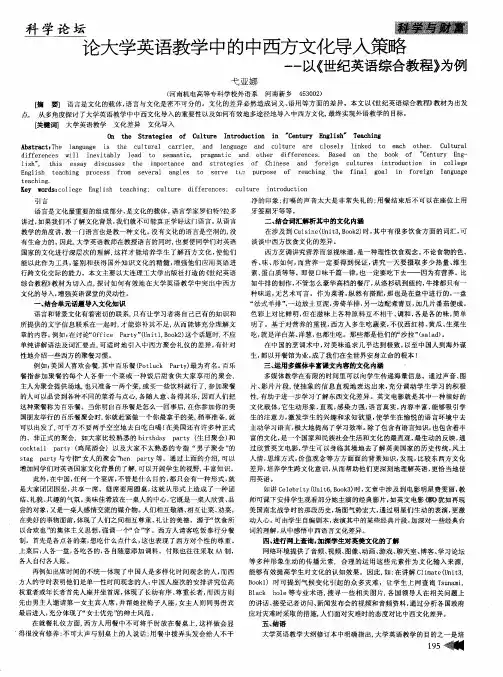
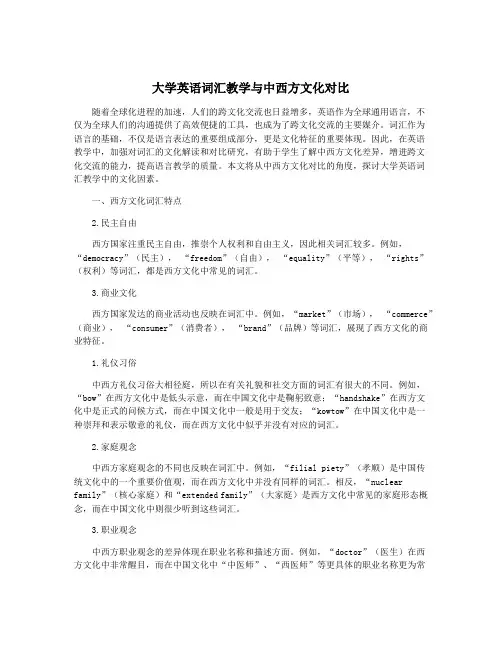
大学英语词汇教学与中西方文化对比随着全球化进程的加速,人们的跨文化交流也日益增多,英语作为全球通用语言,不仅为全球人们的沟通提供了高效便捷的工具,也成为了跨文化交流的主要媒介。
词汇作为语言的基础,不仅是语言表达的重要组成部分,更是文化特征的重要体现。
因此,在英语教学中,加强对词汇的文化解读和对比研究,有助于学生了解中西方文化差异,增进跨文化交流的能力,提高语言教学的质量。
本文将从中西方文化对比的角度,探讨大学英语词汇教学中的文化因素。
一、西方文化词汇特点2.民主自由西方国家注重民主自由,推崇个人权利和自由主义,因此相关词汇较多。
例如,“democracy”(民主),“freedom”(自由),“equality”(平等),“rights”(权利)等词汇,都是西方文化中常见的词汇。
3.商业文化西方国家发达的商业活动也反映在词汇中。
例如,“market”(市场),“commerce”(商业),“consumer”(消费者),“brand”(品牌)等词汇,展现了西方文化的商业特征。
1.礼仪习俗中西方礼仪习俗大相径庭,所以在有关礼貌和社交方面的词汇有很大的不同。
例如,“bow”在西方文化中是低头示意,而在中国文化中是鞠躬致意;“handshake”在西方文化中是正式的问候方式,而在中国文化中一般是用于交友;“kowtow”在中国文化中是一种崇拜和表示敬意的礼仪,而在西方文化中似乎并没有对应的词汇。
2.家庭观念中西方家庭观念的不同也反映在词汇中。
例如,“filial piety”(孝顺)是中国传统文化中的一个重要价值观,而在西方文化中并没有同样的词汇。
相反,“nuclear family”(核心家庭)和“extended family”(大家庭)是西方文化中常见的家庭形态概念,而在中国文化中则很少听到这些词汇。
3.职业观念中西方职业观念的差异体现在职业名称和描述方面。
例如,“doctor”(医生)在西方文化中非常醒目,而在中国文化中“中医师”、“西医师”等更具体的职业名称更为常见;“teacher”(教师)在西方文化中则代表一种高贵、神圣的职业,而在中国文化中更强调教师的实践性和教育效果。
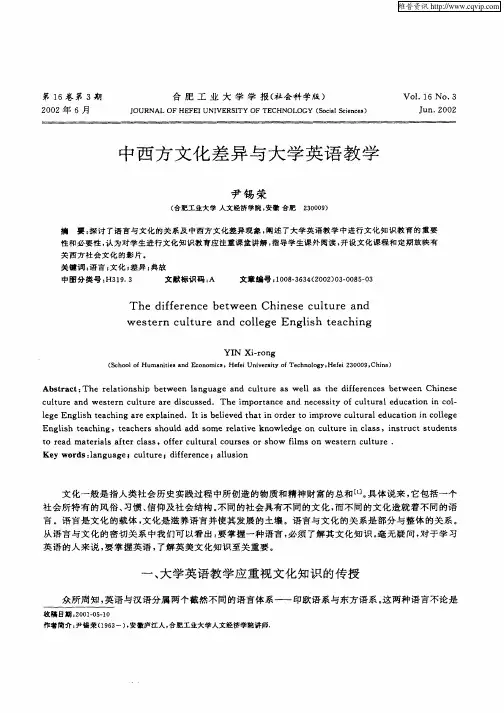
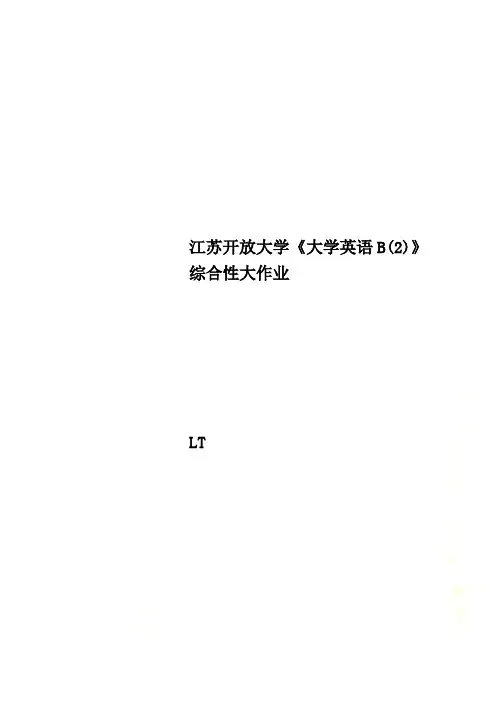
江苏开放大学《大学英语B(2)》综合性大作业LT标题《中西方茶文化差异》正文Differences between Chinese and western tea cultures Tea originated in China, and the earliest writtenrecords date back to the 2nd century BC and then spreadto the west. However, there are different customs fordrinking tea in different cultural backgrounds. Here'sa look at some of the differences between Chinese andwestern tea cultures that have been carefully sortedout for you.(1) different ways of drinking.There are two types of Chinese tea drinking, one is"clear drink", without adding any harmful ingredientsto the original flavor of the tea, and only drink withwater bubbles. The other is "mixed drink", which meansadding salt, sugar and milk to tea according topersonal taste. Currently, this method is mainlyconcentrated in ethnic minority areas.Britons add milk and sugar to their tea to removetheophylline and turn bitter tea into sweet drinks thatsuit their tastes. In addition, the English havereformed the tea itself. Packaged, instant tea scrapsreplace pieces of tea, and Chinese people tend to keepthe whole leaf in boiling water.Western tea can be added milk, sugar, lemon slices and honey, etc., but it is important to note that tea should be poured first, followed by other condiments, in an order that cannot be reversed. After adding the seasonings, stir with the spoon to avoid making too much noise when stirring the tea. Put the spoon on the back of the bowl after stirring.(2) the use of tea sets is differentChina's tea wares are mostly ceramic products, and there are also purple sandboxes for pu 'er tea. The purple sand teapot is breathable, and the pu-erh tea is brewed. The water temperature must be very high. And westerners have a special liking for silver, so most western tea wares are made of silver.The use of tea filters is differentIn China, the chip off a fine cup of tea, such as aged pu-erh tea, need to use iron pot as tools to boil water, then water into the teapot and tea, pour out the first time after water, then add boiled water into the teapot in let stand until the bubble tea, just take a small sample.As is known to all, Chinese people are quite particular about the tea ceremony. In fact, westerners also have a set of etiquette when drinking tea. For example, western teas use a tea strainer, which is placed on a teacup and poured into the cup until it is three-quarters full, so it doesn't spill over the saucer and make a mess.(4) differences in tea drinking etiquette.In the eyes of most Chinese, tea can be drunk at any time. The British are much more tea - loving and tea - respecting. A typical British family drinks tea at least five times a day. When you wake up in the morning, the host will lean on the bed and drink a cup of morning tea to refresh your mind. If there are guests, morning tea is the best way to greet them. Around 11 o 'clock in the morning, black tea with tea; Drink milk tea at lunch; Around five o 'clock in the afternoon is the famous afternoon tea. Drink farewell tea before going to bed at night. In addition, there are many famous tea banquet, garden tea party and so on.(5) differences in the spirit of tea ceremony. Harmony, tranquility, grace and truth are the fournoble truths of Chinese tea ceremony. Harmony is the core of Chinese tea culture philosophy and the soul of tea ceremony. "Quiet" is the only way to practice Chinese tea ceremony. "Just" is the spiritual feeling in the practice of Chinese tea ceremony practice. "True" is the ultimate pursuit of Chinese tea ceremony. Chinese people often drink tea as a spiritual inspiration and emotional sustenance. Unlike the Chinese tea ceremony, the British taste tea more lively and social, emphasizing an elegant style.Oriental tea wares are mostly ceramic products, while western tea wares are mostly silver.Oriental people pay attention to tea ceremony, westerners also have a set of tea ceremony, such as to use a tea filter, to pour tea into the cup to three-quarters full.Chinese tea is the purest flavor of the tea without adding any flavoring to it. Western tea is added milk, sugar, lemon slices and honey, the tea should be poured before adding other condiments, the order cannot be reversed.Tea is not required to be served in the east, but itis often accompanied by tea in the west. The most common ones are Scottish cream biscuits, Victorian muffins and muffins.。

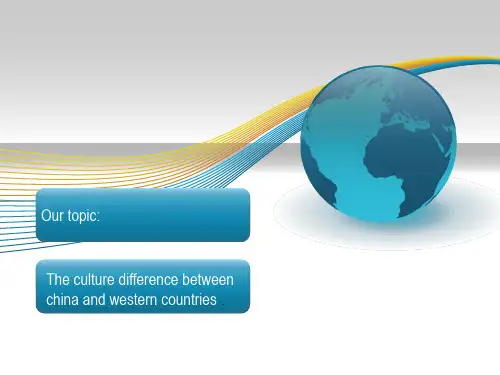
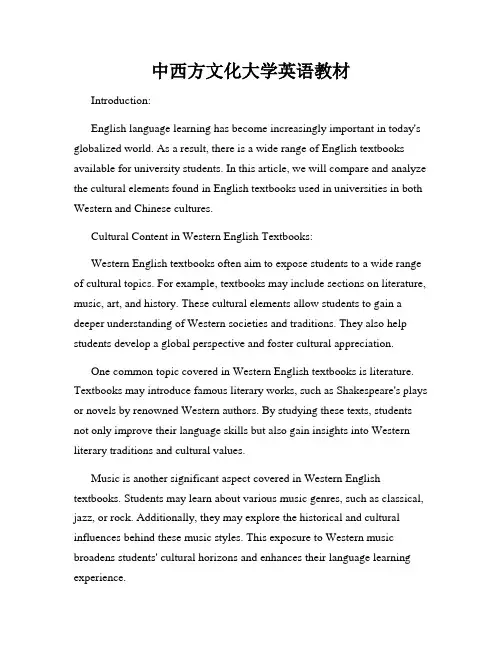
中西方文化大学英语教材Introduction:English language learning has become increasingly important in today's globalized world. As a result, there is a wide range of English textbooks available for university students. In this article, we will compare and analyze the cultural elements found in English textbooks used in universities in both Western and Chinese cultures.Cultural Content in Western English Textbooks:Western English textbooks often aim to expose students to a wide range of cultural topics. For example, textbooks may include sections on literature, music, art, and history. These cultural elements allow students to gain a deeper understanding of Western societies and traditions. They also help students develop a global perspective and foster cultural appreciation.One common topic covered in Western English textbooks is literature. Textbooks may introduce famous literary works, such as Shakespeare's plays or novels by renowned Western authors. By studying these texts, students not only improve their language skills but also gain insights into Western literary traditions and cultural values.Music is another significant aspect covered in Western English textbooks. Students may learn about various music genres, such as classical, jazz, or rock. Additionally, they may explore the historical and cultural influences behind these music styles. This exposure to Western music broadens students' cultural horizons and enhances their language learning experience.Cultural Content in Chinese English Textbooks:In comparison to Western English textbooks, Chinese English textbooks tend to focus more on language acquisition rather than cultural exploration. While there may be some cultural elements incorporated, they are often condensed and integrated into language learning exercises.Chinese English textbooks might introduce Chinese proverbs or idiomatic expressions that reflect specific cultural values. For example, students may learn the proverb "风水轮流转" (fēngshuǐ lúnliú zhuǎn), which means "fortune can change for better or worse." This provides students with a glimpse into Chinese cultural beliefs and mindset.Additionally, Chinese English textbooks may incorporate traditional Chinese festivals and customs. Students might learn about the significance of festivals like Spring Festival (Chinese New Year) or Mid-Autumn Festival, along with associated cultural practices. These topics allow students to understand aspects of Chinese culture while strengthening their language skills.Comparison and Analysis:While Western English textbooks place a heavier emphasis on cultural content, Chinese English textbooks prioritize language acquisition. Both approaches have their merits. Western textbooks expose students to a wide range of cultural topics, facilitating cross-cultural understanding. On the other hand, Chinese textbooks create a more language-focused learning environment.In terms of language fluency and cultural understanding, Western English textbooks may have an advantage. By studying literature and music, students are not only exposed to the language but also the social, historical, and artistic contexts in which it is used. This multi-dimensional approach enhances language fluency and cultural competency simultaneously.However, Chinese English textbooks also play a crucial role by providing students with a solid language foundation. By integrating cultural elements into language exercises, students are exposed to practical language usage while gaining insights into Chinese culture.Conclusion:English textbooks used in universities in both Western and Chinese cultures have unique approaches to incorporating cultural content. Western textbooks focus more on exposing students to various aspects of Western culture, while Chinese textbooks prioritize language acquisition with condensed cultural elements. Both methods contribute to language learning and cultural understanding in their respective contexts. By understanding these differences, educators can select appropriate textbooks to meet the diverse needs of students.。
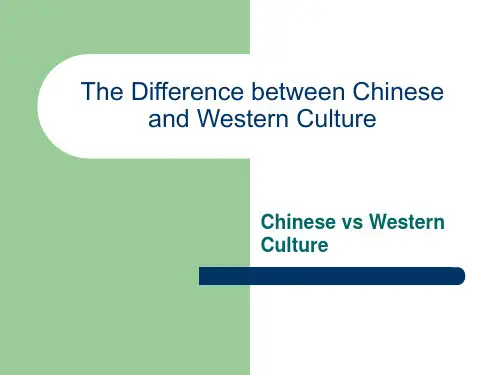
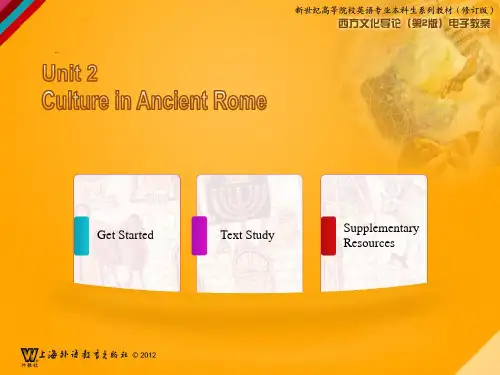
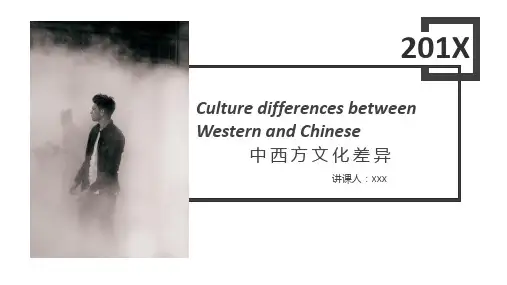
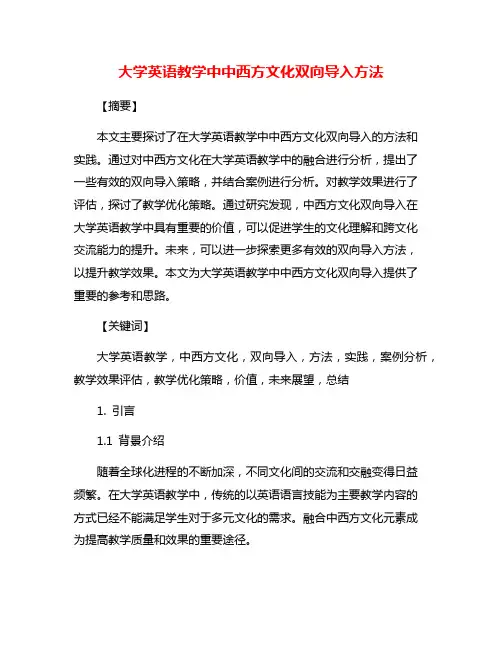
大学英语教学中中西方文化双向导入方法【摘要】本文主要探讨了在大学英语教学中中西方文化双向导入的方法和实践。
通过对中西方文化在大学英语教学中的融合进行分析,提出了一些有效的双向导入策略,并结合案例进行分析。
对教学效果进行了评估,探讨了教学优化策略。
通过研究发现,中西方文化双向导入在大学英语教学中具有重要的价值,可以促进学生的文化理解和跨文化交流能力的提升。
未来,可以进一步探索更多有效的双向导入方法,以提升教学效果。
本文为大学英语教学中中西方文化双向导入提供了重要的参考和思路。
【关键词】大学英语教学,中西方文化,双向导入,方法,实践,案例分析,教学效果评估,教学优化策略,价值,未来展望,总结1. 引言1.1 背景介绍随着全球化进程的不断加深,不同文化间的交流和交融变得日益频繁。
在大学英语教学中,传统的以英语语言技能为主要教学内容的方式已经不能满足学生对于多元文化的需求。
融合中西方文化元素成为提高教学质量和效果的重要途径。
中西方文化之间有着悠久而深厚的历史积淀,不同的价值观、传统习俗和艺术表现形式都展现出独特的魅力。
将中西方文化相结合,不仅有助于学生更好地理解英语语言的背景和内涵,还可以拓展学生的视野,增加文化广度和深度。
借鉴中西方文化的优点和特点,将其融入到大学英语教学中,不仅有利于提高学生对英语学习的兴趣和动力,还可以培养学生的文化素养和跨文化交际能力。
大学英语教学中中西方文化双向导入的方法成为当前教学领域的研究热点,也是提升教学质量和教学效果的重要手段。
1.2 研究意义随着全球化的发展,中西方文化之间的交流与融合愈发频繁。
在大学英语教学中,融入中西方文化元素,不仅可以增加学生的学习兴趣,丰富教学内容,更能帮助学生更全面地了解英语国家的历史、习俗、价值观等。
探讨中西方文化在大学英语教学中的双向导入方法,具有重要的研究意义。
中西方文化双向导入有助于拓展学生的文化视野,促进跨文化交流。
通过在英语教学中引入中国传统文化和西方社会文化,可以帮助学生更好地理解和尊重不同文化背景下的语言使用和沟通习惯,增进多元文化之间的相互理解与尊重。
大学英语词汇教学与中西方文化对比1. 引言1.1 背景介绍英语词汇是学习英语的重要组成部分,掌握丰富的词汇量对于学生提高英语水平至关重要。
在大学英语词汇教学中,往往存在着一些问题和挑战。
随着全球化的进程加快,不同文化之间的交流和融合变得越来越频繁,中西方文化之间的差异在英语词汇教学中也逐渐显现出来。
深入研究中西方文化在大学英语词汇教学中的对比和影响,对于提高教学质量,促进文化交流具有重要的现实意义。
在这种背景下,本文旨在探讨大学英语词汇教学与中西方文化之间的关系,分析其中存在的差异和共同点,探讨如何更好地利用中西方文化之间的差异来丰富词汇教学内容,提高学生的学习效果。
通过对词汇教学方法的探讨和分析,探索更符合不同文化背景学生学习习惯的词汇教学模式。
本文还将从跨文化交流的角度出发,提出改进词汇教学的建议,为未来的词汇教学工作提供一定的参考。
1.2 研究目的:本研究旨在探讨大学英语词汇教学与中西方文化的对比,分析中西方文化在词汇教学中的体现及对教学的影响,探讨教学方法的选择以及跨文化交流的重要性。
通过对比研究,旨在发现中西方文化背景下对大学英语词汇教学的启示和借鉴,提出改进词汇教学的建议,为提高大学生英语词汇水平提供理论支持。
本研究还致力于进一步探讨跨文化交流在词汇教学中的应用,展望未来词汇教学的发展趋势,为推动大学英语词汇教学与跨文化交流的融合做出贡献。
1.3 研究意义大学英语词汇教学与中西方文化对比是一个值得探讨的话题,其研究意义主要体现在以下几个方面:通过对大学英语词汇教学与中西方文化进行对比分析,可以帮助我们更好地理解不同文化背景下学习者的认知特点和学习方式。
由于中西方文化在价值观、思维方式、语言习惯等方面存在差异,对此进行研究能够揭示出不同文化对词汇学习的影响,有助于改进教学方法和策略,提高教学效果。
研究大学英语词汇教学与中西方文化对比还可以促进跨文化交流和理解。
通过深入了解中西方文化的差异与共通之处,可以促进不同文化之间的沟通与融合,增进文化交流的互信和共生,有利于扩大学生的国际视野和跨文化能力。